AIRLINES PILE ON THE ORDERS
by Cathy Buyck
Just two days into the welcome return of the Paris Airshow, airframers are once again finding the event a happy hunting ground for new airliner orders. Much of the new business has come from carriers in Asia and the Pacific Rim, where the post-Covid travel bounceback is prompting fleet expansion. The pressing need to replace older aircraft with less fuel-thirsty models has proved to be another driver of deals signed here this week.
Air India signed the largest contract, for up to 290 new
Boeing jets and 250 Airbus aircraft. Not to be outdone by Indian low-cost carrier IndiGo’s 500-ship order with Airbus on Monday, the flag carrier revealed its selection to renew and expand its fleet with letters of intent signed in February.
The Boeing purchase includes 190 of its 737 Max, twenty 787s, and ten 777Xs with options for 50 more 737 Max jets and twenty 787s. Air India’s Airbus buy includes 140 A320neo and 70 A321neo single-aisle aircraft as well as 34 A350-1000 and six A350-900 widebody jets.
Airbus firmed an incremental order with Qantas for nine continues on page 29
EVTOLS
Paris to be first
Next year’s Olympic Games may see the first paying passengers in an eVTOL aircraft | 06


OEMS
Boom progress
Supersonic aircraft developer sees light at the end of development tunnel | 08
DEFENSE
Special missions
Gulfstream business jets are gaining popularity as military systems platforms | 22
AIRLINES
Lively livery
See Riyadh Air’s possible paint job on a Boeing 787 at the Paris Airshow static display | 27 airshow repor ts GET THE LATEST AIRSHOW NEWS!

DAY 3 JUNE 21, 2023 AINONLINE . COM PARIS AIRSHOW NEWS
Learn more at www.supernal.aero
We’re building new roads in the sky.
DAVID M c INTOSH
Commercial aircraft took the Paris stage as airline orders surged.
The future is our starting point
Every day, we’re working to help move the world forward. Today, and for generations to come. The future of flight starts now.


Airbus reports ‘great progress’ on H2 power
by Cathy Buyck
Airbus has launched a demonstrator program to explore a new architecture for the generation of non-propulsive energy (NPE) by replacing the APU in an A330 widebody with a hydrogen fuel cell system that will generate electricity. Known as HyPower, the hydrogen fuel cell demonstrator also aims to reduce CO2 emissions, nitrogen oxides, and noise levels associated with a traditional APU.
NPE, which generally accounts for about 5 percent of the aircraft’s power needs, traditionally comes from the kerosene-powered APU. “Replacing kerosene [needed by the
P&W opening engine parts factory in Morocco
Following rumors in the Moroccan press in recent months, Pratt & Whitney confirmed Tuesday during the Paris Airshow it will launch an affiliate, Pratt & Whitney Maroc (PWM), in Casablanca to manufacture detailed static and structural machined parts for various engine models.
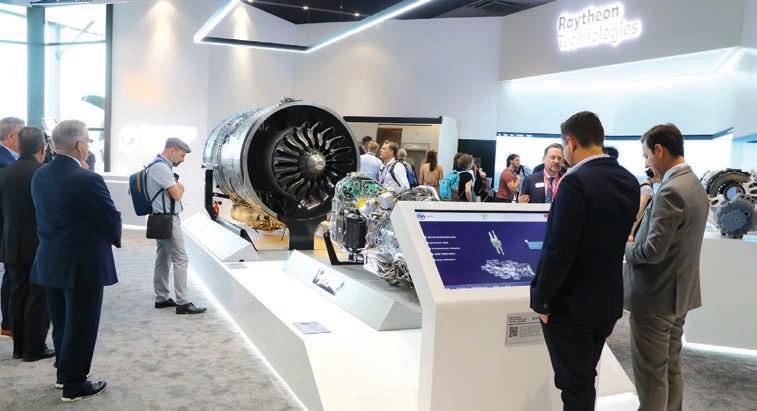
“Morocco offers many benefits for aerospace manufacturing,” said Maria Della Posta, president of Pratt & Whitney Canada. “The growing aerospace community in Casablanca ensures a highly valuable talent pool, a positive economic environment, and the support from Morocco’s government.”
The investment aligns with Raytheon Technologies’ strategy to expand engine
APU] by H2 fuel cells could be very promising for an aircraft powered by fuel cells,” noted Airbus chief technical officer Sabine Klauke.
The company remains convinced that hydrogen (H2)-powered aircraft are “absolutely necessary” for the industry to achieve net-zero carbon emissions by 2050 and claims it has made “significant progress on its H2 journey” over the past six months. Speaking to media at the Paris Airshow on Tuesday, Klauke said the company has made progress in developing its two H2-based propulsion technologies, hydrogen combustion (H2C) and hydrogen fuel. In December Airbus revealed a 100 percent fuel cell-powered aircraft concept, with 100 seats,
six engines, and a range of 1,000 nm.
Both projects run in parallel and both propulsion types could apply to different market segments, said Glenn Llewellyn, Airbus v-p ZEROe Aircraft. “Today, there is no decision. It could be either or, it could be both,” he said. “We are not interested in developing just one hydrogen-powered aircraft,” adding he retains a “high level of confidence that we can achieve our ambition [of having an H2-powered aircraft on the market in 2035].”
“These tests will mark a new step in our decarbonization journey and ZEROe program through an ambitious flight demonstration that will take to the air by the end of 2025,” said Michael Augello, CEO of Airbus UpNext. “We want to demonstrate the operability and integration of the system, including refueling the aircraft with hydrogen. We will demonstrate this system in realistic conditions, climbing to 25,000 feet and flying for one hour with 10 kilograms of gaseous hydrogen on board.” z
manufacturing capacity and be close to airline partners, she said. There are about 3,000 P&W engines flying on the African continent, P&W executives noted during a briefing on Tuesday.
The 130,000-sq-ft greenfield facility will occupy Casablanca’s MidParc Free Zone. Construction will begin in the fourth quarter of 2023 and the company plans to open the plant in 2025. According to Della Posta, the facility will create 200 jobs by 2030.
“P&W investment in Morocco will strengthen our aerospace ecosystem by fostering innovation, research, and the development of new technologies,” said a representative of the Moroccan Ministry of Investment, Convergence, and Evaluation of Public Policies. “It will create job opportunities for our talented youth, foster knowledge transfer, and promote collaboration between local and international stakeholders.” C.B.
4 Paris Airshow News • June 21, 2023 • ainonline.com
Pratt & Whitney, a unit of Raytheon Technologies, manufactures a variety of turbine engines for airliners, military fighters and transports, and all types of general aviation aircraft.
DAVID
M c INTOSH
THE SYMMETRY REVOLUTION
Intuition and intelligence reign with the Gulfstream Symmetry Flight Deck™
Designed with touch-screen displays and active control sidesticks—an industry first— this revolutionary technology drives the next generation of Gulfstream aircraft. Feel the future take flight.

Europe set for 1st eVTOL pax flights
by Charles Alcock
Some lucky Parisians and Olympic Games visitors are set to become the world’s first paying passengers in an eVTOL aircraft. Volocopter on Tuesday confirmed it is on schedule to secure EASA type certification for the twoseat VoloCity aircraft in time for the games, which open on July 26, 2024.
At a Paris Airshow press conference, Edward Cartwright, director general of airports group ADP, confirmed that five aircraft will fly passengers between five vertiport sites, including two airports, Charles de Gaulle and Le Bourget (site of the Olympic media village), Saint-Cyr (near the equestrian center at Versailles), the Issy les Moulineaux helipad in the southern Paris suburbs, and a new landing site on a barge in the Seine River next to the Gare d’Austerlitz rail station. Cartwright described the process for building the Gare d’Austerlitz site as challenging, and ADP plans to award a construction contract soon.
The plan depends on Volocopter getting approval from EASA by the end of the second quarter of next year. Volocopter CEO Dirk Hoke said in July the company will start flying the 200 or so flight hours it needs to satisfy the European air safety agency and it expects to complete the process by the
spring. The German manufacturer plans to apply for an air operator certificate imminently and will start flying a fixed-wing aircraft to demonstrate its competence.
If Volocopter makes its deadline for type certification, it will likely be the first Western company to meet that milestone. Rivals including Joby, Archer, Lilium, Eve, Supernal, and Vertical Aerospace are all now working to dates in 2025 and 2026 to complete this process.
In China, EHang says it will soon gain domestic approval for its two-seat EH-216 autonomous vehicle. And in another press conference on
Nordam to supply nacelles for D328eco
Deutsche Aircraft and Nordam signed a longterm contract at the 2023 Paris Airshow that calls for the Tulsa, Oklahoma-based supplier to design, develop, industrialize, and manufacture engine nacelles for Deutsche Aircraft’s D328eco, a 40-seat twin-turboprop.
Deutsche Aircraft is developing the D328eco to deliver improvements in operational and maintenance costs as well as reductions in the overall carbon footprint. Plans call for the aircraft to operate on
existing aviation fuel or on blends of up to 100 percent H2-Ptl sustainable aviation fuel.
“With the choice of Nordam, we have taken another big step towards securing the supply chain of the D328eco,” said Maximilian Fahr, v-p supply chain at Deutsche Aircraft. “We are investing in a common vision of more sustainable flying.”
Nordam will design and manufacture the D328eco engine nacelles at its facilities in the U.S. and Mexico. C.K.
Volocopter expects to start carrying fare-paying passengers in its eVTOL aircraft in time for next summer’s Olympic Games in Paris.
Tuesday, AutoFlight said it expects the Civil Aviation Administration of China to sign off on a cargo-carrying version of its Prosperity I vehicle.
Hoke acknowledged that it is by no means certain that EASA will grant approval in time for the Olympics, given that the regulator holds eVTOLs to the same safety standard as airliners, meaning they must be assured of suffering no more than one accident in a billion flights, which he said amounts to never. As a plan B, Volocopter could seek a special permit limiting operations to the duration of the games. The company already holds design and production approvals from EASA.
“If you can fly somewhere like Paris, you can fly anywhere,” Hoke said, pointing to the restrictions on helicopter flights around the French capital. He said Volocopter is excited to take the opportunity to demonstrate to the local population that eVTOL air taxis can be an affordable part of the public transportation network. Initially, flight prices will compare to an expensive taxi service, but the company aims to achieve a price of around three or four euros per seat per passenger kilometer.
Volocopter is working on a larger eVTOL vehicle now designated as the VoloConnect, probably with four seats. Hoke said the payload and range for the new aircraft will start to increase meaningfully once battery technology gets beyond an energy density of 400 Wh/kg. z

6 Paris Airshow News • June 21, 2023 • ainonline.com
DAVID M c INTOSH
Cassio 330 prototype preps for flight
by Hanneke Weitering
VoltAero is debuting the first full-scale prototype of its Cassio 330 hybrid-electric aircraft at the Paris Airshow this week. The Cassio 330, which can be configured with either four or five seats, will be the first of three hybrid-electric aircraft that VoltAero intends to produce for cargo, air taxi, and medevac applications.

The French start-up plans to begin flight testing with the newly revealed Cassio 330 prototype later this year. For the upcoming flight test campaign, VoltAero will equip the aircraft with a four-cylinder, 165-kilowatt engine supplied by company partner and strategic investor Kawasaki Motors, a company best known for its motorcycle engine products.
VoltAero expects a second Cassio 330 prototype, which the company will use for its airworthiness certification program, to take flight in the second quarter of 2024. That version will become the first to fly using VoltAero’s new hybrid-electric propulsion system, which consists of Kawasaki’s four-cylinder thermal engine and Safran’s EngineUs 100 smart electric motor.
The second Cassio 330 prototype will also come equipped with Avidyne’s new Quantum avionics platform. The full interior of the five-seat Cassio 330 model, including the new
avionics suite, is on display at the Paris Airshow this week.
Subsequent Cassio models will include the six-seat Cassio 480 and the 12-seat Cassio 600. The Cassio 480, which will produce a combined hybrid-electric propulsion power of 480 kilowatts, will use a six-cylinder thermal engine also provided by Kawasaki. VoltAero has not yet announced which engine will power the larger, 600-kilowatt Cassio 600.
VoltAero has partnered with French company Akira Technologies for the integration and validation of Cassio’s hybrid propulsion
The Cassio 330 prototype made its Paris Airshow debut and is slated for first flight later this year. The aircraft features a hybrid-electric propulsion system.
unit, including the engine and motors. Akira Technologies will also take responsibility for the design, development, and ground testing of the gearbox, according to VoltAero.
Each of the Cassio aircraft will use only electric power during taxi, takeoff, and landing, while the hybrid engine feature will activate during cruise flight to function as a range extender that recharges the batteries. The hybrid system also serves as a backup in case of a problem with the electric propulsion. VoltAero says its aircraft will be able to operate on sustainable biofuels as well as hydrogen power in the future. z
Ground Master 400 radars picked for Indonesia air defense
Indonesia has selected the Thales Ground Master 400 Alpha radar to enhance its air defenses. The nation will acquire 13 of the longrange air surveillance radars along with the SkyView command and control system. Thales works with local company PT Lens to supply the systems to the Indonesian air force.
The GM400 Alpha contract builds on a joint venture the two companies announced in November 2022, which they created to perform maintenance, repair, and overhaul on existing air force radars. The companies expect activities to start next year. They plan additional collaboration for topics such as military satellites and combat management systems.
For the GM400 Alpha contract, Thales builds the radars and
command and control system, while PT Lens builds the radar stations and installs the radars while managing associated civil works. PT Lens plans to manufacture certain radar components locally as part of an e ort to strengthen Indonesia’s defense industry.
GM400 Alpha is a proven long-range radar renowned for its performance against low-altitude targets. Its digital architecture allows for continual upgrades to meet emerging threats and to remain resistant to electronic warfare and cyber attacks. The SkyView system provides a 360-degree air surveillance picture based on data from the radar network and integrates air operating centers at local, regional, and national levels. D.D.
ainonline.com • June 21, 2023 • Paris Airshow News 7
DAVID M c INTOSH
Boom adds supersonic suppliers
by Chad Trautvetter
Boom Aerospace’s Overture supersonic airliner remains on schedule for FAA certification by the end of this decade, founder and CEO Blake Scholl maintained on Tuesday at the 2023 Paris Airshow. As proof of progress, he announced aerostructures suppliers for Overture 1, the first of its commercial models, and provided an update on the airplane’s homegrown Symphony engine program, including the naming of a production partner.
The company said it recently signed agreements with Aernnova for Overture’s wings, Leonardo for the fuselage and wing box, and Aciturri for the empennage. The structures are fully composite. Previously revealed suppliers include Safran Landing Systems, Eaton, Collins Aerospace, FlightSafety International, Florida Turbine Technologies (FTT), GE Additive, and StandardAero.
It also shared more details on Symphony’s engine architecture and specifications at the airshow, along with unveiling a 3D-printed one-third-scale model. According to Scholl, the
medium-bypass engine “leverages certified technology” to lower risk. Optimized for supersonic flight, the engine will consist of already-certified materials and use a conventional core. What’s new is the engine intake and nozzles, he said.
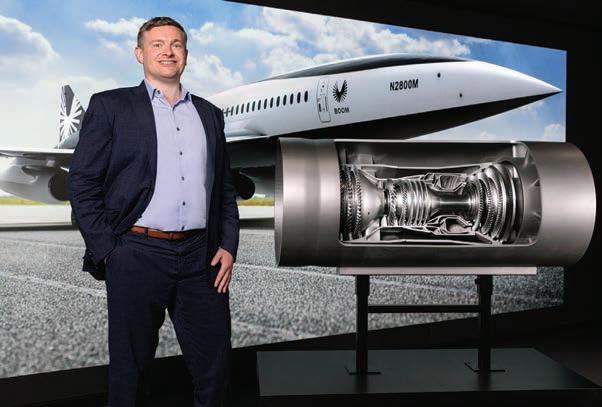
Boom also expanded its partnership with FTT to develop the initial production engines for ground test, flight test, and certification. It also has identified Jupiter, Florida, as the
GE, Clemson U win $10M ceramics grant
GE Aerospace and South Carolina-based Clemson University recently received a $10 million grant from the U.S. Air Force to continue joint research of high-temperature ceramic-matrix composites and ultra-high-temperature ceramic-matrix composites, the organizations said on Tuesday at the 2023 Paris Airshow. This research will bolster national security, improve engine efficiency, and enhance the structural safety of aircraft, they added. GE and Clemson have collaborated on ceramic materials research for about 10 years.
Rajendra Bordia, chair of the ceramics and materials engineering department at Clemson, serves as the principal investigator for the project. “When most hear about
ceramics, they think the material is brittle,” he told AIN . “But these advanced ceramics are very tough and can withstand high heat and temperatures. They can be used for static and rotational parts of turbine engines. In fact, they may even be used to mitigate frictional heat on leading edges of supersonic and hypersonic airplanes.”
The USAF grant will help advance next-generation ceramic materials. “This provides an opportunity to push the boundaries even further,” noted GE Edison Works president and CEO Tony Mathis.
Meanwhile, Clemson broke ground last month on a 140,000-sq-ft (13,006-sq-m) advanced materials research facility, which it expects to open in 2025. C.T.
remains confident that the supersonic Overture 1 will achieve FAA certification by 2030, including the aircraft’s in-house designed and built engine.
base for initial production. Scholl said the company plans to announce a location for full-rate engine production later.
Scholl also directly addressed the XB-1 “baby Boom” scale demonstrator, which rolled out as planned in late 2020 but has fallen almost two years behind schedule in achieving flight. He said the company moved the aircraft to Mojave, California, for “safety testing” and will fly it later this year.
However, Scholl admitted that the XB-1 and Overture programs “diverged” due to design refinements of the latter airplane, putting into question what benefits, if any, the company could glean from even flying the demonstrator. Asked if he would still do XB-1 in hindsight, the company chief told AIN he would. “With XB-1, we learned a lot about building an engineering team and safety culture,” he said. “It was a worthwhile exercise.”
Meanwhile, company advisor Phil Condit lent more credibility to the program by briefly speaking at Boom’s press conference—marking his first Paris Airshow appearance since 2003, when he retired as Boeing’s chairman and CEO. Having been involved in Boeing’s stillborn supersonic programs, Condit said his work on Overture “brings me full circle.”
Boom estimates a 2027 first flight for Overture, and expects certification and service entry in 2029. Plans call for iron bird testing at Boom’s Denver headquarters to start next year. z
8 Paris Airshow News • June 21, 2023 • ainonline.com
Boom Aerospace founder and CEO Blake Scholl


©2023 GE Additive. All Rights Reserved. MACHINES | POWDERS | SOFTWARE | CONSULTING A metal additive partner you can trust. Improve product performance, simplify the supply chain, and reduce production lead time with proven metal additive solutions. Ready to accelerate your path to full metal additive production? GE Additive has the products, solutions, and expertise to help. Get started at ge.com/additive/fasterpath On the shop floor and in the skies.
Military variant of AW609 appears likely
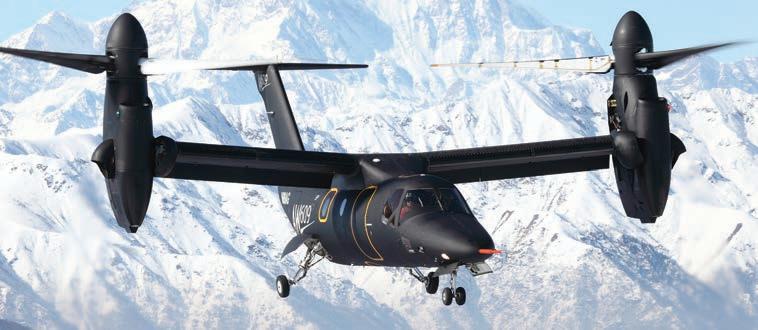 by Mark Huber
by Mark Huber
Leonardo’s acquisition of Bell’s share of the AW609 tiltrotor program in 2011 raised widespread speculation regarding the terms of the agreement, specifically about whether it precluded an armed, militarized version of the aircraft from ever coming to market. That conjecture increased last year when Leonardo Helicopters managing director Gian Piero Cutillo revealed that the company entered talks with the Italian government on the AW609, perhaps to develop a para-public version of the aircraft.
Then, in December, the U.S. Army awarded Bell the contract to develop its V-280 tiltrotor prototype into the Future Long-Range Assault Aircraft. The V-280 has a maximum cruise speed approaching 300 knots, more than 100 knots faster than attack helicopters such as the current Boeing AH-64 Apache or the proposed Future Attack and Reconnaissance Aircraft, for which Bell and Sikorsky remain in competition. The award led to further speculation about the future military utility of the AW609, this time as a possible escort aircraft for the V-280.
Neither Bell nor Leonardo will publicly comment on the terms of the AW609 deal. However, a variety of governments, including the UAE and Malaysia, have expressed interest in the aircraft, believed linked to surveillance, patrol, medevac, or search and rescue configurations. A Bell spokesman contacted by AIN referred comment to Leonardo, which declined to disclose the details of the contract. “However, we can share that we see great interest in the AW609 from military users in roles including patrol, SAR, and special operations,” said a Leonardo spokesperson.
Tiltrotors have served as research aircraft since the 1950s. The Bell-Boeing V-22 made its first flight in 1989 before going into operation in 2007, first with the U.S. Marine Corps and then with the U.S. Air Force, and now the
U.S. Navy as a carrier onboard delivery aircraft. Altogether, more than 400 V-22 family aircraft have been delivered. While providing military forces with unique capabilities, the V-22 has drawn frequent criticism for its high development and unit costs, maintenance complexities, and comparatively low rate of operational readiness. In a scathing critique of the aircraft delivered in May, U.S. Sen. Chris Murphy (D-CT), whose state hosts Sikorsky’s headquarters and main manufacturing facilities, claimed the V-22 registered an operational readiness of 56 percent, a current unit cost of $100 million, and a 15-year gestation period.
from a European customer.
Leonardo’s reticence to discuss price is fueling the hypothesis that the aircraft needs to attract substantial para-public and even military orders for the program to succeed commercially.
Since 2011, the AW609 has undergone if not a redesign, then certainly an optimization of the original design and supply chain. The cabin height has increased from 54 to 60 inches, width now spans 58 inches, and length totals 13 feet, 5 inches—dimensions that make the AW609 just as large or more spacious than popular business turboprops. Leonardo gave the main cabin door a clamshell design and widened it to 35 inches, making the 609 more suitable for a medevac role, especially when fitted with an integrated 600-pound hoist. With auxiliary tanks, the 270-knot AW609 flies to a maximum unrefueled range of 1,000 nm. The aircraft is powered by a pair of Pratt & Whitney Canada
While demonstrably smaller, the AW609 features the basic architecture of the V-22, namely proprotors attached to engines that swivel to provide both vertical and horizontal flight and various degrees of transition between. The aircraft’s unit cost to the end user has generated further industry speculation, which initially placed it on par with conventional super-medium civil helicopters. But Leonardo has steadfastly refused to publicly disclose a likely price range for the aircraft, nor the size of its order book. However, it has disclosed select individual orders, from offshore operator Bristow and a four-ship order
PT6C-67A turboshafts and equipped with Collins Pro Line Fusion touchscreen avionics. In a utility/military configuration, the cabin can accommodate 12 passengers and two crew.
Flight testing of the aircraft is largely complete, and pilots from the FAA and EASA flew the aircraft earlier this year for familiarization purposes. Leonardo has been working with the FAA on a certification basis for the aircraft independent of powered lift category regulations now under development, so it is conceivable, but not certain, that it could gain certification this year or early next year. z
Governments have expressed interest in the Leonardo AW609 tiltrotor for use in search-and-rescue applications among other uses.
10 Paris Airshow News • June 21, 2023 • ainonline.com
Operational Excellence

SPONSOR CONTENT
New tech to extend life of Eurofighter Tranche 4
by Reuben F. Johnson
In an effort to maintain the Eurofighter’s relevance to the air combat environment until the German-French FCAS and the Italy-Japan-UK GCAP/Tempest enter production, program partners have kept busy upgrading onboard systems for retrofit. The upgrades, which will come as part of the configuration for new-build aircraft for Germany, will first appear on existing aircraft in the UK and among the other partners.
Last year, the original Eurofighter partner nations laid plans to upgrade some of the Tranche 3 aircraft in their collective inventories and—in the case of Germany and Spain— procure a new, Tranche 4 batch of aircraft. The Royal Air Force (RAF) upgrades of its current aircraft call for an almost $3 billion replacement of the older-generation electronic systems with state-of-the-art hardware.

Germany’s part of the multi-nation program, Project Quadriga, calls for the Luftwaffe to procure 30 single-seat and eight two-seat versions of the Tranche 4 aircraft to replace 38 Tranche 1 aircraft set for retirement.
The Tranche 1 aircraft still operated by the original four partners—the UK, Germany, Spain, and Italy— are the subject of a proposal for the Ukrainian Air Force requirement for a Western-design fighter aircraft.
The new-build Tranche 4 aircraft will come equipped with a new active electronic scanning array (AESA) radar set, called the E-Scan European common radar system (ECRS).
Plans call for the new-build models to support the Luftwaffe’s Eurofighter fleet into the 2060 decade. By that time, the aircraft would be flying missions in conjunction with the new-generation Franco-German-Spanish Future Combat Air System (FCAS) design. Between the two, Eurofighter production lines will remain active through 2030 and potentially beyond.
In the UK, 40 Tranche 3 aircraft in service— and possibly some of the 67 Tranche 2 aircraft
as well—will receive an upgrade dubbed the Phased 4 Enhancement (P4E) timed for integration with the introduction of the ECRS. The modifications will feature a new mission management and cockpit interface, modernization of the GPS and navigation functions, and a new electronic counter-countermeasure system to neutralize advanced electronic warfare systems.
The BAE Systems facility at Warton, which manufactures Eurofighter models for the UK, points out the new system upgrades, plus the new production models for Germany and Spain and all of the testing and integration work performed for the ECRS AESA radar, will keep the line occupied for some time.
Such an interruption would prove disruptive, but not fatal, to the company, and industry observers have pointed out to AIN that shutdowns on the Tornado line lasting three years preceded the Eurofighter project. However, Warton kept the facility ready for a re-start, which was not cost-free, but it prevented production capacity from atrophying.
The new radar and other electronic systems involve joint efforts between the Eurofighter team members in the different countries. The ECRS and other systems supplied for the Luftwaffe aircraft will come from German defense electronics firm Hensoldt. It would build the radar and other systems for the 38 German Tranche 4 aircraft and the hardware for the Luftwaffe retrofit of its Tranche 2 and 3 models.
Hensoldt serves as one of the industry partners in the multinational EuroRadar consortium; the others are Leonardo in the UK and Italy, and Indra in Spain. The company’s role traces back to the design of the first-iteration AESA radar, originally designated
The plan for sustaining the production capacity for the program would dovetail the winding down of Eurofighter activity with the ramp-up of the Global Combat Air Program (GCAP)—a UK-Italy-Japan Tempest project to develop another next-generation model aircraft that would theoretically serve as an analog to the FCAS.
Next-gen programs unfortunately have a habit of both kicking off later and running for longer than originally planned. Although plans call for the GCAP to undergo low-rate initial production (LRIP) by 2035 (Italy is calling for delivery of export versions by 2040), if that date slips, the Warton plant could see a “gap” in its fighter production line.
Upgrades to the electronics of the latestmodel Eurofighter will help ensure its continued utility into the second half of this century.
the Captor-E, Radar 1+, and ECRS Mk0, and produced for the Eurofighter export models ordered by Kuwait and Qatar.
While producing the Mk1 models, the German firm will also be a supplier for the follow-on iteration—the Mk2 design under development for the RAF Eurofighters, for which Leonardo has taken the lead role. The companies expect demand for those ECRS models to increase as retrofit programs for additional older-model Eurofighters expand.
While the new aircraft represent an important phase at the end of the Eurofighter’s production history, the electronics enhancements ensure its operation well into the second half of this century. z
12 Paris Airshow News • June 21, 2023 • ainonline.com
Thanks to our experience and R&D network, we are developing innovative technologies for the next generation of propulsion systems to support commercial and military aviation.

We are the European partner of choice for military and commercial propulsion.

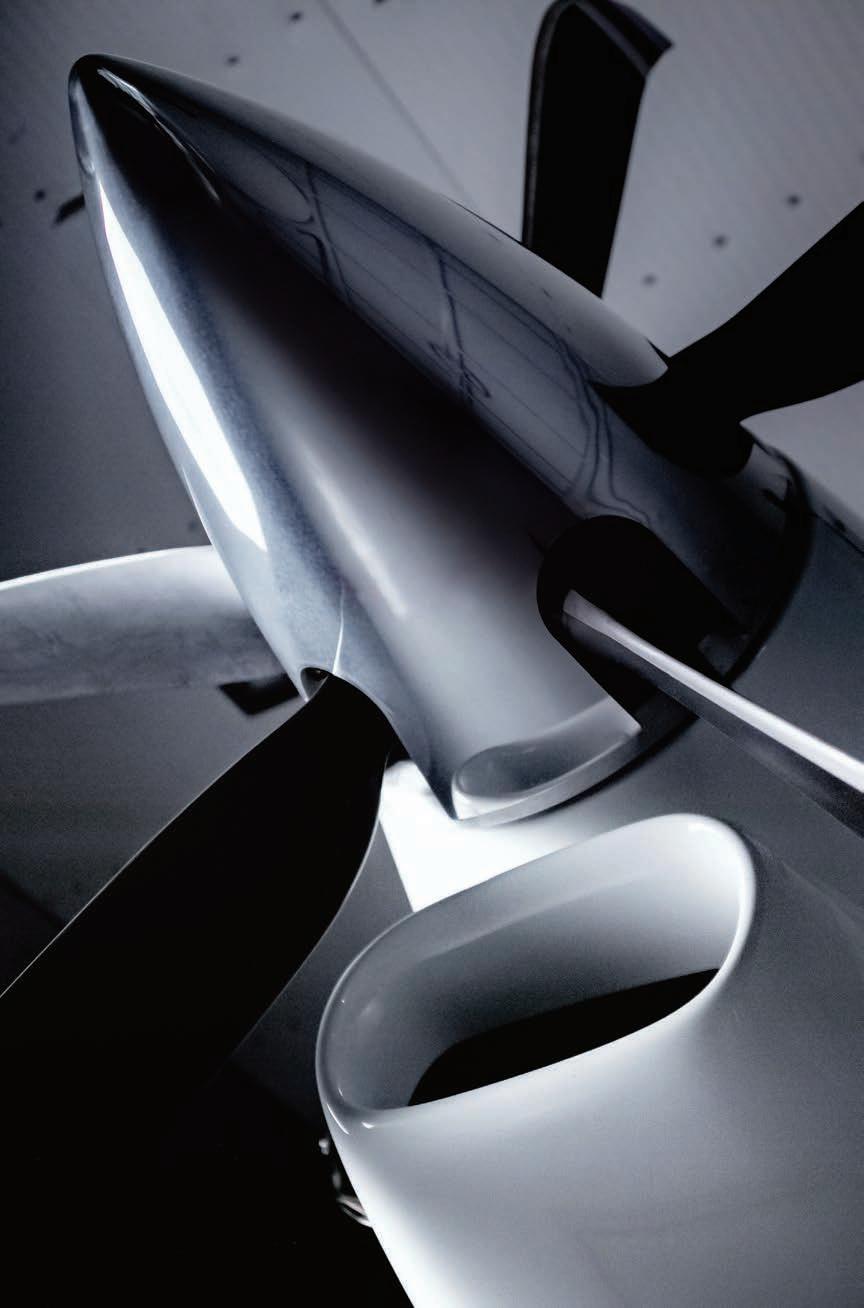
We are helping shape a more sustainable future of flight.
Paris salon showcases hybrid-electric EcoPulse
by Hanneke Weitering
The EcoPulse, a hybrid-electric technology demonstrator jointly developed by Daher, Safran, and Airbus, is making its public debut this week at the Paris Airshow.

Having completed the first flight tests in 2022 using a conventional thermal engine, the EcoPulse team is now working to integrate the hybrid-electric propulsion system and plans to fly the converted aircraft for the first time this summer.
Using a Daher TBM 900 single-engine turboprop converted with a hybrid-electric powertrain, the EcoPulse project intends to evaluate the advantages of a hybrid-electric distributed propulsion system, such as increased efficiency and the reduction of carbon-dioxide emissions and noise pollution.
Airbus holds responsibility for optimizing the aerodynamics and the battery system while Safran develops the hybrid-propulsion system, which consists
of six integrated electric thrusters distributed across the wing.
According to Daher, the EcoPulse team recently completed initial ground testing of the new propulsion system, validating its aerodynamics and systems configuration. In March, the hybrid-electric EcoPulse logged 10 flight hours with two of its six motors installed and subsequently flew with a four-motor configuration in April. Now the team has completed the installation of all six motors ahead of the aircraft’s debut at the show.
“The demonstrator has so far amassed around 27 hours of flight time with the electric propellers feathered,” said Daher chief technology o ffi cer Pascal Laguerre. “From this demonstration program, we plan to develop our future product roadmap and basically spec the hybrid aircraft we intend to produce by the end of our five-year plan. We expect by the end of 2027 to be able to offer our first hybrid aircraft to the market.” z
Supernal adds more SA-1 eVTOL supplier partners
Supernal, a Hyundai subsidiary dedicated to urban air mobility, announced two key manufacturing partners for its SA-1 eVTOL air taxi during the Paris Airshow on Monday.
GKN Aerospace has agreed to provide the electrical wiring interconnection system and lightweight aerostructures for Supernal’s aircraft. Meanwhile, Qarbon Aerospace will use its advanced induction-welding techniques to assemble thermoplastic carbon-composite components for the SA-1.
The partners will work together to scale manufacturing technology and enable high-rate, lower-cost manufacturing processes. “Instead of focusing on ‘time to market,’ Supernal is prioritizing ‘time to scale,’” said Jaiwon Shin, Supernal CEO and president of Hyundai Motor Group. He added that Hyundai Motor Group’s automotive manufacturing expertise will also help to bolster manufacturing rates and reduce the cost and time of aircraft production.
“By incorporating advanced materials and processes in our manufacturing strategy from the start, Supernal will be prepared to expand eVTOL vehicle production capacity to meet demand surges when the industry takes off,” Shin said.
Supernal chief commercial officer Adam Slepian told AIN that the company intends to begin flying its first full-scale technology demonstrator aircraft toward the end of 2024, and the production aircraft will be ready to enter service in 2028. The company expects to produce several iterations of technology demonstrators and prototypes before settling on a “locked form” that will be used for certification testing, he said. H.W.
14 Paris Airshow News • June 21, 2023 • ainonline.com
DAVID M c
A project developed by Daher, Safran, and Airbus, the EcoPulse is designed to evaluate distributed hybrid-electric powertrain systems using a converted conventional single-engine turboprop.
INTOSH
Unison is a leading provider of electrical and mechanical aerospace components and solutions.
As an existing supplier to nearly every engine and airframe program, Unison helps deliver the performance its customers need for the most challenging environments – both in the skies and beyond.

Our customers are reaching new heights. We’re helping them get there.
92% asset availability

LEADERS AREN’T BORN. THEY’RE ENGINEERED.
Another reason to say LEAP. By example.
*Compared to 83% for competition, per third-party data.
That means fewer spare aircraft and more flights, which helps profitability climb.
LEAP-powered aircraft are achieving the highest days flown ratio* for their thrust class.
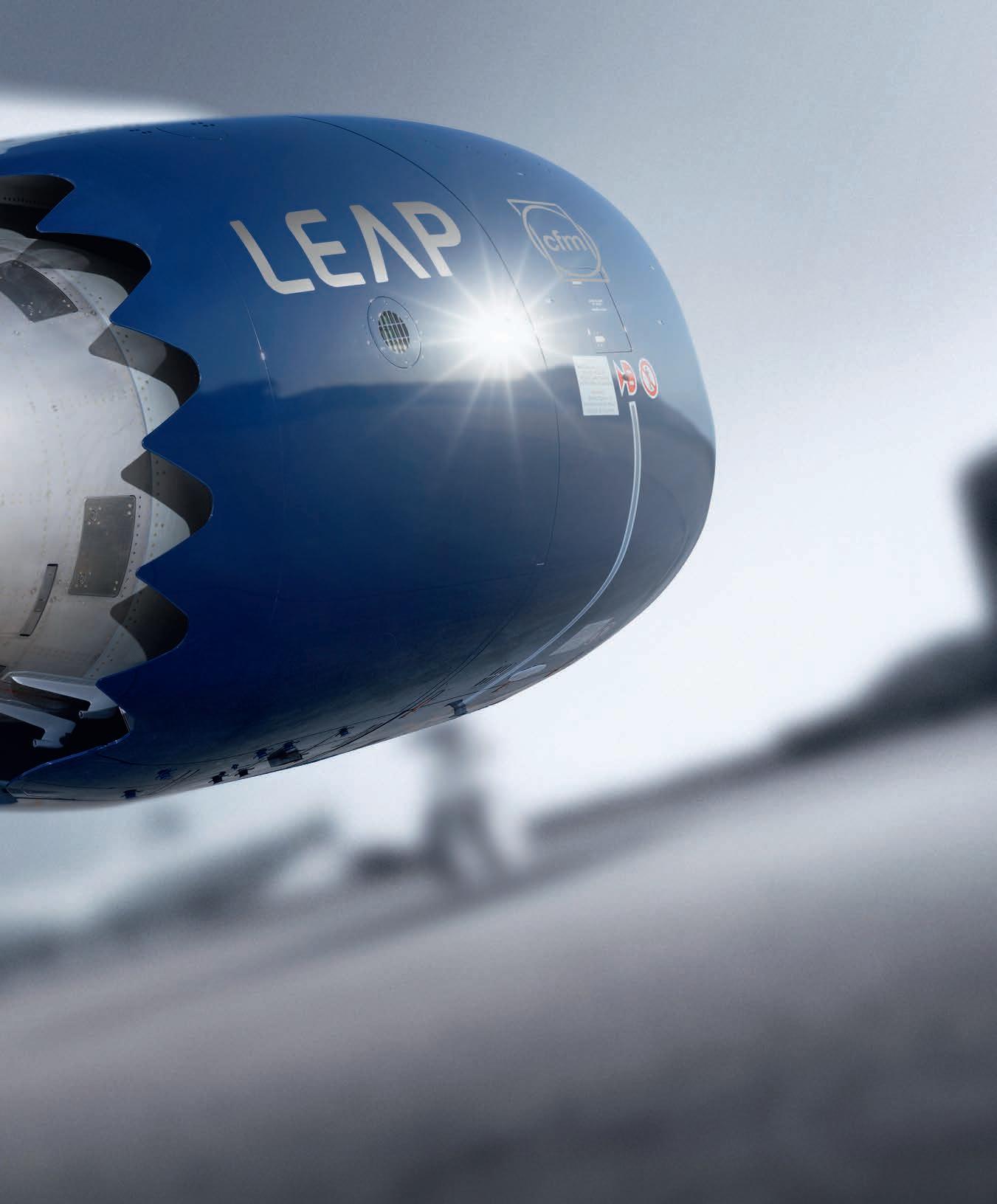
LEAP turns heads in the boardroom.
cfmaeroengines.com
H2Fly’s H175 hydrogen fuel cell systems will power regional airliners carrying between 20 and 80 passengers.
H2Fly launches higher flying H2 fuel cells
by Charles Alcock
H2Fly this week announced plans for a new family of fuel cell systems that can operate at altitudes of up to 27,000 feet. The German company said the H175 technology will be scalable for a variety of hydrogen-electric aircraft in the 1-MW class and seating between 20 and 80 passengers.
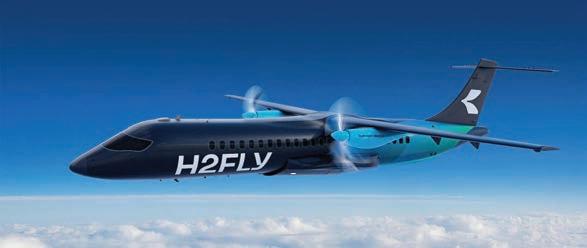
According to H2Fly, the new propulsion
systems will represent a significant step up in performance compared with hydrogen fuel cell demonstrator aircraft flown to date. The company aims to conduct its first flight demonstrations later this year as it works toward readying the new propulsion system for commercial service in 2027.
The new program is part of H2Fly’s existing partnership with Deutsche Aircraft. The companies will integrate the fuel cells into a
Dornier 328 aircraft used to develop the new D328eco model.
The work also is part of the “328 H2-FC” project funded by the German Ministry for Economic Affairs and Climate Change. Several other partners are involved in efforts to develop a hydrogen-electric fuel cell system.
“With the H175 we are introducing a completely new generation of aviation-grade fuel cell systems pushing forward the state of the art in the industry,” said H2Fly CEO and co-founder Josef Kallo. The program constitutes part of the European Union’s Project Heaven initiative to develop liquid-hydrogen propulsion for airliners.
The planned flight trials will use H2Fly’s HY4 demonstrator aircraft, which the company has already used to evaluate earlier systems. Specifications show a range of up to 250 km and can fly at altitudes of up to 27,000 feet. Last year, the HY4 set what H2Fly claimed as a world altitude record for a hydrogen-powered passenger aircraft, reaching 7,230 feet.
According to H2Fly, several airlines have shown interest in adopting the H175 fuel cells as either retrofits for existing aircraft or for new models. z
Tamarack to install SmartWing winglets on SkyAlps Q400s
Italian airline SkyAlps has signed a letter of intent with Tamarack Aerospace for the installation of active winglets on its De Havilland Q400 fleet, which it expects to reach 14 aircraft early next year. The airline also plans avionics upgrades for its Q400s.

Tamarack Eco-SmartWing active winglets will improve the performance and safety of SkyAlps’s modified fleet while o ering significantly reduced emissions, noise pollution reduction, and “meaningful” fuel savings, according to the companies. The active winglets are designed to alleviate gust loads, minimizing additional structural weight needed for the winglet installation and thus providing a greater e ciency improvement compared with passive winglets.
Although the companies haven’t finished with final details, SkyAlps plans a demonstration tour with its modified Q400, starting from Bolzano, Italy, then to Dubai, UAE, and onward to Tokyo, Japan, in November.
Other airlines’ aircraft could benefit from Tamarack’s active winglets, which the company has made available on many Cessna CitationJet models. “It’s not exclusive to SkyAlps,” Guida said. “We want to outfit as many as we can. Since the June 16 [announcement], we
have had several other Q400 operators call us and ask. The bigger the fleet the better. In the whole fleet, there are 586 [Q400s]. I’d love to have half of those.”
SkyAlps accountable manager Alex Spinato said he could not divulge information on the planned avionics upgrades to the Q400 because final details remain incomplete. “We are working hard to improve the avionics of the Q400, at least at SkyAlps,” he told AIN. “At the moment, we cannot share the avionics brand because we are still discussing it with the provider. We believe that with new avionics, we can save fuel and weight. The avionics upgrade is our second main target.” P.S.-S.
18 Paris Airshow News • June 21, 2023 • ainonline.com




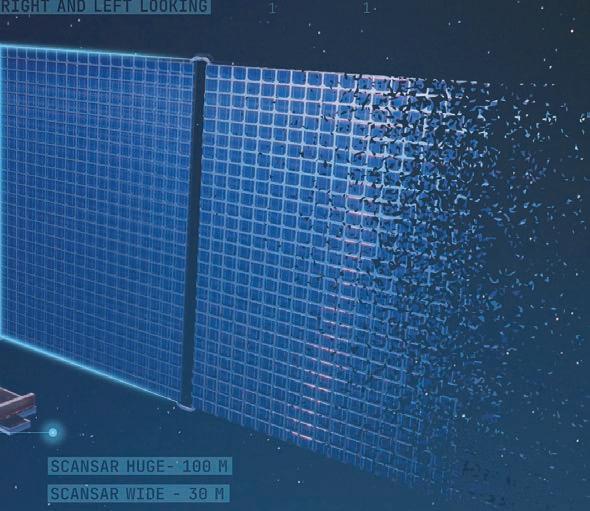



EVOLVES HERE. Leonardo builds a sustainable future through industrial ACCELERATING TECHNOLOGY EVOLUTION Leonardo builds a sustainable future through industrial capability, investing in strategic skills leonardo.com Leonardo is home to the sustainable future thanks to its long-term vision, consisting of engineering expertise, knowledge and skills. It exploits the digital to enhance its legacy businesses, accelerating technological evolution. Visit us at Le Bourget, Chalet 250, Static Area B6
TECHNOLOGY
Boeing commits to sustainable future
 by Cathy Buyck
by Cathy Buyck
Keen to highlight its contributions to decarbonize aerospace and conform to environmental, social, and corporate governance (ESG) practices increasingly demanded by shareholders and customers, Boeing earlier this month released its 2023 sustainability report.
Titled “Sustainable Aerospace Together,” the report provides an annual update on the U.S. company’s efforts to advance environmental stewardship, human development,
and inclusion. Boeing’s work includes addressing the company’s sustainability goals on employee safety and well-being; global aerospace safety; community engagement; diversity, equity, and inclusion; as well as sustainable operations and clean technology innovation.
“Boeing continues to invest and make progress on our journey to achieve a more sustainable aerospace future,” said Chris Raymond, Boeing chief sustainability officer. “As we enter a new era of sustainable aerospace, we
are committed to documenting our progress and outlining our path forward with transparency so our industry can progress, together.”
Efforts span from increasing renewable energy use in its factories and purchasing more sustainable aviation fuel (SAF) for commercial operations. Last year, Boeing purchased 2 million gallons of SAF and it achieved 35 percent renewable electricity use across the company in 2022 by purchasing renewable electricity and renewable energy credits. Two years earlier its renewable electricity use amounted to 21 percent of the total.
The company also continues investments in aerospace technologies to reduce fuel use, emissions, and noise. For example, it recently launched the Boeing Cascade Climate Impact Model, a data-modeling tool that quantifies strategies to reduce aviation emissions. Meanwhile, NASA chose Boeing to develop and flight-test the full-scale Transonic trussbraced wing Sustainable Flight Demonstrator.
Last year also marked the 10th anniversary of the Boeing ecoDemonstrator program, which has evaluated some 230 technologies to reduce fuel use, emissions, and noise. The 2022 program tested 30 new technologies to help decarbonize aviation on Boeing’s 777200 test bed. z
Honeywell, Curtiss-Wright certify cockpit voice and data recorder
A 25-hour all-in-one cockpit voice and flight data recorder jointly developed by Honeywell and Curtiss-Wright has gained certification for the Boeing 737, 767, and 777. Operators of the Boeing models can order the Honeywell Connecter Recorder-25 (HCR-25) directly from the aircraft OEM or Honeywell. The certification also marks the introduction of the first Curtiss-Wright product for the three airliner types, the companies said.

Based on Curtiss-Wright’s compact and lightweight Fortress CVR and the Honeywell Flight Recorder 5, the HCR-25 meets the latest EASA requirements for 25-hour cockpit voice recording for aircraft weighing more than 27,000 kilograms (59,525 pounds). In addition to fulfilling mandates, the HCR-25 permits real-time data streaming and cloud-upload capabilities via Honeywell’s Connected Aircraft software, which in turn allows for remote retrieval of data from the aircraft for storage or analysis.
The HCR-25 provides an aircraft recording solution supporting parametric flight data, four channels of cockpit voice recording,
and CPDLC message recording for up to 25 hours each. Additionally, the unit meets RTCA DO-178C and DO-254 standards and includes a 90-day ultrasonic locator beacon certified to FAA TSO-C121b. It can withstand an impact shock of 3,400 g for 6.5 milliseconds, according to Honeywell. C.T.
20 Paris Airshow News • June 21, 2023 • ainonline.com
Boeing’s support of sustainable aerospace programs is reflected in its ecoDemonstrator.
The HCR-25 combines cockpit voice and flight data recorder functions with data streaming and cloud-upload capabilities.

Gulfstream’s growing special missions business
by David Donald
L3Harris is in the process of delivering the first of a new class of special-missions aircraft, based on the Gulfstream G550 airframe, to the U.S. Air Force. The EC-37B is an electronic attack platform that targets the enemy’s command and control communications network, as well as radars and navigation systems. Currently the role—known as Compass Call—is handled by the Lockheed EC-130H, a variant of the Hercules. The fleet has been in service since 1982 and, following a lengthy career that included active service in all of the major U.S. military actions over four decades, is ready for replacement.
L3Harris is the lead systems integrator in what is known as the Compass Call Rehost team, alongside Gulfstream and BAE Systems. As its name suggests, the program ports the current Compass Call Baseline 3 system from the EC-130H into the G550. Five Gulfstreams are currently receiving this system and should be in service with the 355th Electronic Combat Group at Davis-Monthan AFB in Arizona by year-end.
Following these initial aircraft will be at least five more with the Baseline 4 system. This employs BAE Systems’ Sword-A technology, with software-defined components and an opensystems architecture. This will allow the system
to be updated quickly to meet emerging threats without requiring physical adaptation. The Air Force plans to operate at least 10 EC-37Bs but may expand the fleet to 14 to replace the current EC-130Hs on a one-for-one basis.
Choosing the G550 as a platform for the system highlights the growing trend to employ larger business jet types for the specialmissions arena that were once performed by modified airliners or military transports. Advances in electronics have shrunk the size of the mission systems considerably, as well as their power requirements.
Similarly, increased automation, the rise of artificial intelligence, and the improvement in datalink communications have greatly reduced the number of human operators required onboard the aircraft. Compared with earlier platforms, the modern business jet also provides improved range performance, and also higher service ceilings, increasing the effective horizon for surveillance systems. Modern business jet cabin environments also make life far more comfortable for the crew.
Gulfstream is not the only manufacturer to benefit from this trend. Bombardier has seen its Challenger 650 and Global Express/6000/6500 employed for a number of electronic missions—notably the Global 6000-based GlobalEye multi-sensor
reconnaissance/airborne early warning aircraft for the United Arab Emirates. Dassault’s Falcon family has also been adapted to a number of electronics roles, and the company is currently working on the Archange, a signals intelligence (Sigint) gatherer for the French air force based on the Falcon 8X.

Gulfstream’s Legacy
Gulfstream, of course, is no stranger to the special-missions world, and the sector remains an important element of the company’s portfolio. The original turboprop-powered Gulfstream I was the basis of the U.S. Navy’s TC-4C Academe multi-engine trainer, and the jet-powered Gulfstream II, III, and IV have all been modified for a variety of special missions.
Perhaps the most notable are the two Gulfstream IV-SPs converted for Sigint gathering. Known in service as the S 102B Korpen (raven), the Gulfstreams have recently been active along NATO’s border with Ukraine. Large numbers of Gulfstreams have been acquired by governments and air forces for VIP and staff transport duties, those in U.S. service being designated VC-11 (GII), C-20 (GIII/IV), and C-37 (GV/550).
Perhaps the most important development was the creation of the G550-based Conformal Airborne Early Warning (CAEW) variant, which first flew in May 2006. Developed in concert with Israel Aircraft Industries, the CAEW is a radical modification of the aircraft to house the Elta EL/W-2085 radar system. This is a 360-degree AEW suite developed from the EL/W-2075 Phalcon for the Boeing 707.
In the G550 application, the system comprises two large side-looking L-band phased arrays on either side of the fuselage, with S-band arrays in the nose and tail to complete the 360-degree coverage. Huge fairings were created for the side arrays, while the S-band arrays are covered by large bulged radomes. Completing the major airframe modifications is a large bulged fairing at the top of the fin to house satellite communications antennas.
As well as the major aerodynamic modifications, the CAEW has numerous changes internally, including revised cabling, three power generators instead of one, and a liquid cooling system. The flight deck retains the Gulfstream PlaneView cockpit with Honeywell Primus
22 Paris Airshow News • June 21, 2023 • ainonline.com
The U.S. Navy’s single NC-37B range support aircraft, serves with VX-30 “Bloodhounds” at NAS Point Mugu, California.
Epic avionics. Six operators are accommodated in the rear of the cabin, while the forward cabin houses most of the electronics along the sides, including the transmit/receive modules for the side-facing arrays.
CAEW aircraft entered service with Israel in February 2008, known locally as the Eitam. Singapore acquired four to replace its E-2 Hawkeyes, and subsequently Italy acquired two CAEW machines that have played their part in proividing AEW coverage along the border with Ukraine. They are also in Italian service as E-550As.
CAEW and Sigint Derivatives


Clearing the much-modified aerodynamics of the CAEW for service has smoothed the path for a number of derivatives that employ the same modifications. The first was the NC-37B, a single aircraft employed by the U.S. Navy’s VX-30 for range support duties over the Pacific missile test range. The EC-37B Compass Call aircraft for the Air Force also employs the CAEW aerodynamic configuration.
Experience with the CAEW led Israel to co-develop another variant, known as the Special Electronic Mission Aircraft, or Shavit in Israeli service. This features an Elta EL/I3001 Sigint system with a large canoe fairing for housing electronic surveillance antennas. It retains the fin-top satcom bulge. Collectively the Israeli-modified Gulfstreams are called Nachshon, and the latest derivative to appear is the Oron. This returns to the CAEW configuration but has a multi-sensor suite that performs surveillance roles such as maritime intelligence-gathering and aerial imaging. The EL/W-2085 radar and AEW role are retained.
In 2015, Australia joined the Gulfstream special-missions club, ordering two aircraft to be known as the MC-55A Peregrine in Royal Australian Air Force service. As many as five could be bought of this version, which is equipped with the Airborne Intelligence, Surveillance, Reconnaissance, and Electronic Warfare (AISREW) multi-sensor system. Flight trials got underway at Gulfstream’s Savannah, Georgia headquarters in May 2022.

The MC-55A features an underbelly canoe fairing but also has a tail bulge and satcom fairing similar to those of the CAEW aircraft.
Italy has also acquired two AISREW-equipped Sigint versions of the G550 to answer its Joint Airborne Multi-sensor Multi-mission System (JAMMS) requirement. They will replace the single Aeritalia G-222VS that was used for many years. The first arrived in Italy in May 2022 but appeared to have not yet received its mission equipment, which is to be integrated by L3Harris and includes the Leonardo Osprey 50 radar.
Additionally, Italy has bought six “green” G550s for modification to special-missions configurations at a later date, which will ultimately raise its number of special-missions Gulfstreams to 10. It has not been made public which configurations the additional machines will be modified to. It recently emerged that the Italian air force is looking at two or perhaps three of them being completed as electronic attack platforms, using similar mission equipment to that installed in the EC-37B Compass Call aircraft. z
ainonline.com • June 21, 2023 • Paris Airshow News 23
Sikorsky pushes X2 for NATO nextgen program
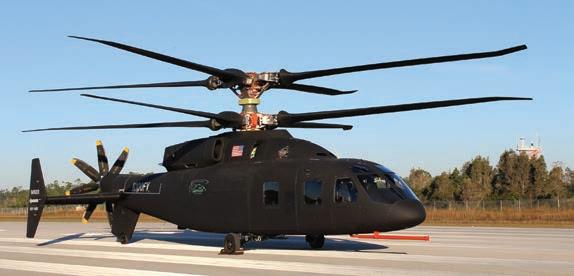 by Mark Huber
by Mark Huber
Sikorsky continues to investigate new markets for its X2 compound coaxial helicopter technology following the loss of its recent protest appeal to the U.S. Government Accountability Office (GAO) of the U.S. Army’s Future Long Range Assault Aircraft (FLRAA) award to Bell. In February, Sikorsky unveiled plans to potentially offer an aircraft positioned between the Raider-X, its ongoing effort to compete in the Army’s Future Attack and Reconnaissance Aircraft (FARA) program, and the Defiant-X design it proposed for the FLRAA in partnership with Boeing.
Sikorsky would offer the helicopter in a utility configuration and as a possible eventual replacement for the NH Industries Airbus/Leonardo joint venture fly-by-wire twin NH90. The OEM unveiled its multi-role “International Twin” concept at Defense IQ’s international military helicopter conference in London earlier this year and again at the Helicopter Association International’s HeliExpo in Atlanta in March.
Paul Lemmo, Sikorsky CEO and president, said the company targets the international utility market for the twin-engine International Twin and that it was working collaboratively with Leonardo on a study involving the design for the Italian government to see how X2 “fits into their [NATO’s] next-generation helicopter program.” Sikorsky also is “closely watching” the “next generation rotorcraft capability” requirement under development by NATO. “We certainly think that X2 fits very well with a number of requirements they have and we will continue to work on that as time moves on. There’s a lot going on with X2 even though we did not have a positive decision on the FLRAA program.”
NATO announced the Next Generation Rotorcraft Capability (NGRC) project—a collaboration between the defense departments of France, Germany, Greece, Italy, and the UK— in November 2020. NATO has set a target for
the NGRC to enter service as NH-90s retire beginning in 2035. Subsequently, the Netherlands also joined the program. Spain and the U.S. joined as observers. As currently constituted, the program envisions a production run to last to at least 2059 with three major block changes along the way. Several major feasibility studies have begun. Broad goals for the program include a unit cost not to exceed $37 million each, an open systems architecture, and an availability rate not below 75 percent.
Along with Sikorsky’s X2 technology, the design of the compound Airbus Racer (rapid and cost-efficient rotorcraft) technology demonstrator could also find its way into the mix of possible technologies. Plans call for the Racer to make its first flight later this year. Airbus designed the aircraft to cruise nearly twice as fast as a conventional helicopter, at cruise speeds of up to 220 knots. The design stems from the European Commission’s H2020 research program as part of the Clean Sky 2 initiative. A pair of 2,500-shp Safran Aneto-1X engines that provide 25 percent more power the similar-sized engines would power it. The Racer can achieve up to a 15 percent reduction in fuel burn when one of the two engines is placed in standby mode during cruise flight, a configuration Safran calls “Eco Mode.” The design features two pusher propellers mounted to a fixed tandem wing and a five-bladed main rotor. The wings provide additional vertical lift and the ability to fly farther and faster than conventional helicopters.
Airbus developed the Racer from its retired X3 technology demonstrator, which achieved a top forward speed of 255 knots.
While improvements have been made, dissatisfaction with the fly-by-wire NH90 continues. In 2019, Germany temporarily grounded all of its pre-2018 production NH90s due to tail rotor problems. In 2021, Australia decided to ditch its fleet of marinized NH-90s, designated MRH90, a decade ahead of schedule due to chronic parts availability and maintenance issues. Last year Norway terminated its contract to acquire 14 NH90 medium-lift helicopters it intended to use for coast guard patrol and anti-submarine warfare missions. Citing 20 years of frustration with the NH90 helicopter program, the Norwegian government additionally requested a full refund from NHIndustries. The program began in 1995 and delivered its first helicopter in 2007. According to the company website, it delivered 471 units across 20 different variants to a variety of armed forces, primarily in Europe. The twin-engine helicopter features fly-by-wire flight controls, a useful load of 9,260 pounds, a maximum speed of 162 knots, and a range of 530 nm. It was designed to provide a European-made alternative to Sikorsky’s ubiquitous UH-60 Black Hawk.
While NATO appears eager for an NH90 replacement, given the GAO’s harsh critique of Sikorsky’s FLRAA protest, the company will need to do some convincing to become a player with its International Twin in the NGRC. The agency faulted the helicopter maker for failing “to provide the level of architectural detail required by the [request for proposal].” Nevertheless, Sikorsky’s Lemmo remains optimistic about X2 technology and the prospects for the International Twin. “We believe this delivers revolutionary capability in speed, range, maneuverability, and survivability,” he said. z
24 Paris Airshow News • June 21, 2023 • ainonline.com
Sikorsky proposed the Defiant-X design for the U.S. Army’s Future Long Range Assault Aircraft in partnership with Boeing. The company lost its bid for the contract to Bell.

Collins Aerospace picked for ATM projects
by Cathy Buyck
Collins Aerospace will contribute to the efforts to drive the modernization of Europe’s air traffic management (ATM) system with its selection by the EU’s Single European Sky ATM Research (Sesar) public-private partnership to participate in eight projects to accelerate the digital transformation of the continent’s ATM.
As part of the Digital European Sky initiative, Raytheon Technologies’ Collins Aerospace unit will work with other stakeholders in the ATM ecosystem including air navigation service providers, airlines, aircraft OEMs, system providers, and academia to foster new technology innovations in connectivity, U-space, trajectory-based operations, airport solutions, autonomy, and data services. Collins will lead the Jarvis (just a rather very intelligent system) project that will leverage artificial intelligence-based
technologies to increase automation in the flight deck and control tower operations as a way to reduce pilot and operator workload while enhancing safety and security.

“Collins has decades of experience in avionics and air traffic management that we will bring to bear under the EU’s Sesar 3 joint undertaking as we work with our industry partners to chart the future of the European sky,” said Mauro Atalla, senior v-p of engineering and technology for Collins. “Together, we will develop new solutions that will form the foundation of a future system that is more efficient, safe, and secure.”
The eight projects consist of CNS DSP (demonstration of a CNS data service provision), Echo 2 (European concept for higher altitude operations phase 2), Ensure (ATM-Uspace interface and airspace reconfiguration service), Jarvis, FCDI (future connectivity
and digital infrastructure), Network TBO (trajectory-based operations), SEC-airspace (cybersecurity risk assessment in virtualized airspace scenarios), and Spatio (U-space separation management).
Separately, Sesar will appear at the airshow’s Paris Air Lab where it will showcase projects that support a transition to greener aviation, including greener taxiing, climate-optimized trajectories, and more energy-efficient approaches and landings at airports. z
Curtiss-Wright lands further flight test instrumentation work
Curtiss-Wright continues to underline its capabilities in the flight test instrumentation sector. The company has announced a $24 million contract with Nellis Air Force Base for flight test instrumentation (FTI) to support the F-35 Technology Refresh (TR-3) program that provides a series of upgrades to the F-35’s software and hardware.
Curtiss-Wright has supported Nellis with FTI solutions since 1998 and for the last three years worked with the base, the Naval Air Warfare Center Aircraft Division, and the F-35 Joint Program O ce to define the distributed FTI system that enables the test and evaluation of the F-35 TR-3.
In Europe, Airbus chose the company to provide FTI equipment for installation on a Eurofighter Typhoon instrumented production aircraft. Curtiss-Wright will provide data acquisition and encoding units that capture flight test data from the structure, engines, and other systems. Meanwhile, Curtiss-Wright’s Dublin facility has received EASA Part 21 certification, allowing it to provide data acquisition units to in-service aircraft and expanding its business beyond purely FTI products.
In support of the F-35 TR-3 program, Curtiss-Wright has secured a $24 million contract to supply flight test instruments.
In related news, Scientific Research has received a supplemental type certificate for the use of Curtiss-Wright’s Fortress CVR25 recorder in the Beechcraft T-6 Texan II trainer. Fortress combines voice and flight data recorders, integrated data acquisition, independent power, and a quick-access recorder based on an SD card. D.D.

26 Paris Airshow News • June 21, 2023 • ainonline.com
Collins Aerospace is participating in eight ATM projects for the Single European Sky program.
Riyadh Air fleet to fly with ‘dual-livery’ design
by Cathy Buyck
Riyadh Air is showcasing its lavender-indigo livery on a Boeing-owned 787 at the Paris Airshow and plans to reveal a second livery later this year or early next year. “We are going dual-livery. We are a start-up, the largest start-up in commercial aviation in decades, and it needs a story,” remarked Riyadh Air CEO Tony Douglas at a Paris Airshow media event. He remained tight-lipped on whether or not the livery will retain the same color scheme, but disclosed the current livery would not exclusively appear on the 787s it has on order.

The airline remains in the process of selecting a narrowbody and will not announce an order at the Paris Airshow. The order, which could include up to 150 Boeing 737 Max jets, will likely be announced “between the Paris Airshow and the Dubai Airshow…before the end of the year,” executives told AIN
The Saudi start-up expects to launch operations in early 2025 using the widebodies on an international network that will eventually span all major capitals. The narrowbodies will support its domestic network, Douglas said. By 2030, Riyadh Air wants to fly to 100 destinations.

Riyadh Air placed a firm order for 39 Boeing 787-9s, with options for a further 33 in March, as part of a wider deal with Saudi Arabian carrier Saudia for a combined 121 Boeing 787s.
Environmental performance factored as a “big part of the selection” of its widebody fleet and would also drive the choice of its narrowbodies, Douglas said. He intends to fuel Riyadh Air’s aircraft with a blend of sustainable
aviation fuel (SAF) from the beginning, he told AIN, indicating it could be locally produced and sourced SAF. “We will need to be a thought champion in sustainability,” he stressed. “You will have heard me say before that I believe that airlines that don’t focus on sustainability may be forced out of business.”
He declined to disclose the delivery schedule of the 787s on order and told AIN
Air managed to secure delivery slots from 2025 through 2030 because discussions started a “long time” before the March announcement.
Douglas emphasized that Boeing’s commitment to timely delivery of the 787s is part of the deal. “They have made those commitments,” Douglas said. He added there was a “very mature understanding that if they fail to

ainonline.com • June 21, 2023 • Paris Airshow News 27
M c
Speak with the Experts! Hall A, Stand #3-G203 www.ofsoptics.com FlightLinx® PLUS
Cable A lightweight, ruggedized cable design for improved fuel efficiency and reduced weight.
A possible livery for Riyadh Air’s jets can be seen on the Boeing-owned 787 on display at the Paris salon. DAVID
INTOSH
Fiber Optic
Rolls-Royce has tested an AE2100-A turbine adapted to run on gaseous hydrogen fuel. The first runs took place in an outdoor test facility at MoD Boscombe Down.

Rolls-Royce gears up for future flight customers
by David Donald
Despite the growth of electric motors for aviation, the gas turbine engine will continue to provide power for many years to come, according to Rolls-Royce. One of the “big three” players in the global aircraft propulsion field, Rolls avers that only gas turbines can provide the necessary power density to propel large aircraft over long ranges. Even for small aircraft on shorter ranges, the gas turbine plays a part in providing power as part of a hybrid-electric propulsion system, such as the 600- to 1,200-kilowatt turbogenerator announced by the company this week at the Paris Airshow.
Tackling sustainability stands at the heart of Rolls-Royce technology efforts, including the development of electrical power units. For the gas turbines, however, the company is focusing on efficiency and adapting them to cleaner and ultimately zero-carbon fuel sources.
The UltraFan demonstrator showcases the company’s commitment to more e ffi cient engines. Early tests have proved encouraging, with full power tests due for later this year. The UltraFan’s geared architecture and optimized turbine/case clearances form part of a technology drive to create an efficiency increase of 10 percent over the Trent XWB series, which itself improved on the preceding
Leasing group signs electric Alice LOI
Aerolease plans to add up to 50 all-electric Alice aircraft under a letter of intent signed with Eviation Aircraft on Tuesday. The Miami-based group plans to o er the nine-passenger model under finance and leasing terms to operators.
Eviation launched the Alice program at the 2019 Paris show, but the fixed-wing aircraft has undergone a fundamental redesign since then. In September 2022, the U.S. company made a short first flight at Moses Lake in Washington state but has not flown it since and now says it intends to start certification testing in 2025 as it aims to start deliveries in 2027.
Trent 700 by 15 percent.
Rolls-Royce has begun clearing its engine range for 100 percent sustainable aviation fuel (SAF) use while preparing alongside Boeing and Virgin Atlantic for a 100 percent SAF transatlantic flight later this year with a Trent 1000-powered Boeing 787. Blended SAF essentially serves as a drop-in replacement for traditional jet fuel. Adoption of 100 percent SAF is more an issue of gaining approval rather than clearing technical hurdles. For the future, however, the brightest promise comes from liquid hydrogen fuel. The main challenges involve the transportation of a cryogenic liquid held at very low temperatures (-253 deg C) and turning it into a gas that can combust with minimal emissions of gases such as nitrogen oxide at room temperature.
Rolls-Royce, in partnership with EasyJet, has already tested hydrogen fuel in gaseous form in an adapted AE2100-A turbine. The November 2022 test, which used hydrogen produced in the Orkney Islands by EMEC using renewable energy, was the first run of a modern engine using hydrogen.
Now the company has embarked on a test campaign of a Pearl 15 engine to initially clear 100 percent SAF for use, before trials begin with gaseous hydrogen fuel. Ultimate plans call for the campaign to demonstrate operation with a liquid hydrogen fuel source. z
The Alice would fly to a standard range of around 250 nm on a single electric charge, and Eviation believes range could increase to 440 nm when improved batteries become available.
Eviation plans to o er an “executive” six-seater version of the aircraft, as well as a freighter with a 2,600-pound payload. Initial type certification will be under FAA Part 23 rules.
“We work with major airlines around the world, and we know from many conversations that sustainability is a major concern,” said Aerolease managing partner Jep Thornton. “New projects that address sustainability are key to our future strategy and we are excited to be working with Eviation to o er our global customers a zero-emissions solution that is good for the planet and provides an exciting means of opening up new regional routes.”
According to Eviation CEO Gregory Davis, the value of provisional sales commitments logged so far for the Alice totals $4 billion. For Aerolease, the intended purchase of an electric aircraft represents a departure from its core portfolio, which so far has consisted of cargo conversions of aging passenger airliners. C.A.
28 Paris Airshow News • June 21, 2023 • ainonline.com
Orders pile up
A220-300s, bringing the Australian carrier’s total backlog for the single-aisle type to 29 aircraft. Qantas chose the A220 as part of a major fleet replacement program announced in May 2022, which also included orders for the A321XLR and A350-1000.
The manufacturer also finalized a memorandum of understanding agreed with Philippine Airlines in May for the purchase of nine A350-1000s. Airbus plans to start deliveries in the second half of 2025 and continue shipments into 2027, Airbus CCO and head of international Christian Scherer said during a signing ceremony. The A350-1000s are part of the Philippine carrier’s ultra-long-haul fleet project and will fly on nonstop service from Manila to North America.
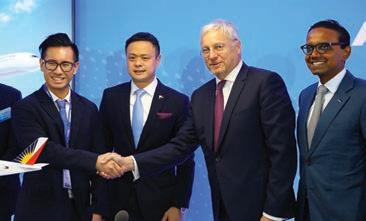
Expanding its capacity to take advantage of rising post-Covid international travel, China Airlines exercised options to add eight Boeing 787s
to its fleet. That came as part of an agreement for 16 of the widebodies signed last year, with the carrier only now identified as the customer.
Boeing said 787s are now selling faster than ever, with more than 250 orders and commitments in the past six months. AerCap announced on Tuesday it has signed a lease agreement with El Al for a pair of 787-9s.
Leasing group Avolon is back in the market for 737 Max jets for the first time since 2017, placing an order for 40 of the 737-8 model.
Air Algérie confirmed an order for eight 737-9 Max jets, swelling its fleet of the Boeing narrowbody family, which already includes 30 aircraft. The North African carrier also signed a MoU for a pair of Boeing Converted Freighters.
Lessors Azorra and Avolon boosted Embraer’s backlog with the former signing for 15 of its E195-E2 single-aisle aircraft and the latter reporting a sale and leaseback arrangement with Porter Airlines for 10 more of the type. Spain’s Binter ordered half a dozen more E195-E2s. American Airlines ordered seven of the smaller E175 model for its regional affiliate Envoy Air.

Twin turboprop maker ATR notched 22 more firm orders, plus two options, covering both its ATR 72 and ATR 42 turboprops. Taiwan’s Mandarin Airlines ordered half a dozen ATR 72-600s, while Malaysia-based Berjaya Air is taking two more equipped in an all-business class configuration. Brazil’s Azul plans to take three more ATR 72-600s and now holds options for another two. Meanwhile, five undisclosed customers signed contracts for eight ATR 72-600s and three of the smaller ATR 42. z
INERTIAL SYSTEMS ENSURING MISSION SAFETY AND PERFORMANCE
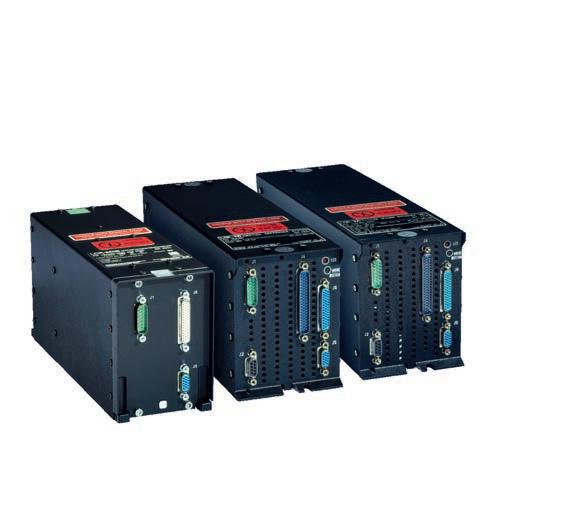
ainonline.com • June 21, 2023 • Paris Airshow News 29
With light weight, small volume, outstanding environmental robustness and unmatched performance LITEF’s LCR Family of Inertial Systems deliver value to the operators of all types of civil and military aircraft.
LCR-350B
LCR-110
US AT PARIS AIR SHOW 2C-C328
LCR-100
VISIT
Philippine Airlines president Lucio Tan III (left) and Airbus CCO Christian Scherer shake hands on the airline’s order for nine A350-1000s.
continued from page 1
Raytheon Tech’s demo makes first engine run
by Peter Shaw-Smith
Raytheon Technologies’ Pratt & Whitney and Collins Aerospace units have made significant progress on advancing hybrid-electric propulsion through the Scalable Turboelectric Powertrain Technology (STEP-Tech) demonstrator, which has completed its first engine run and electrical system integration test.
As a modular and scalable demonstrator platform, STEP-Tech provides for rapid prototyping of distributed propulsion concepts applicable to a range of next-generation applications, including advanced air mobility vehicles, high-speed eVTOL aircraft, and blended wing body aircraft, Raytheon said.

“Hybrid-electric propulsion is a key part of Raytheon Technologies’ roadmap for enabling more sustainable aviation, with the potential to enhance efficiency across many future aircraft applications, from advanced air mobility to regional aircraft and single-aisles,” said Raytheon Technologies chief technology officer Mark Russell.
Conducted at the Raytheon Technologies Research Center in East Hartford, Connecticut, the successful test included the first run of STEP-Tech’s turbogenerator loaded at partial power, Raytheon Technologies said. An electrical system test followed, where the battery and supercapacitor energy storage
Military UAS sector continues to expand
Unmanned aerial systems (UAS) will continue to proliferate and remain a dynamic business sector throughout the coming decade, reports Teal Group’s 2022/23 market study. Estimates suggest that annual spending on UAS procurement will rise from $12.1 billion in 2023 to $16.4 billion in 2032. The procurement spend across the decade will total $162.2 billion, along with a further $72.5 billion of research spending, says the study, which includes estimates of the classified programs undertaken mainly in the U.S.
While the forecast projects that the U.S. will account for 81 percent of the global
research and development budget in the UAS sector—and 48 percent of procurement—the study notes that China and Turkey have exerted increasing pressure on the traditional domination of the market by the U.S. and Israel, notably in the Middle East. The study includes reviews and forecasts for the UAS sensor marketplace, which it projects will grow from $5.5 billion in FY22 to $11.8 billion in FY31. Radars will rank as the best-performing sensor sector, reports the Teal Group. In terms of trends, the study foresees growth in the market for sensors for small UASs as capabilities trickle down from the larger platforms. D.D.
systems were integrated with the high-voltage distribution system. The next test will include a full-power turbogenerator run and validation of the propulsors.
With support from the governments of Canada and Quebec, Raytheon Technologies is also advancing hybrid-electric propulsion as part of its hybrid-electric flight demonstrator program. The work involves a collaboration with the Sustainable Water-Injecting Turbofan Comprising Hybrid-Electrics (SWITCH) consortium, with assistance from the European Union’s Clean Aviation Joint Undertaking.
Through such demonstrator programs, Raytheon Technologies aims to develop a broad portfolio of sustainable aviation technologies via collaboration across its business units and through industry and public-private partnerships. The strategy embraces the continual advance of aircraft efficiency and the enabling of wider use of sustainable aviation fuel to support civil aviation’s goal of net-zero CO2 emissions by 2050. z
30 Paris Airshow News • June 21, 2023 • ainonline.com
online AIN logo: C 0 M 100 Y 63 B 12 Hex: D31245 RGB: R 211 G 18 B 69 Online: font: Myriad Pro semi extended AINonline logo THERE IS LOTS MORE ONLINE! go to .com for further coverage of the Paris Air Show
STEP-Tech provides distributed propulsion concepts applicable to advanced air mobility vehicles, high-speed eVTOL aircraft, and blended wing body aircraft.
A FORCE TO BE CONNECTED WITH.

Engineering
Dowty is a leading supplier of electronically controlled, allcomposite propeller systems to the global turboprop market.
We are committed to pioneering next generation propulsion technologies and partnering with customers to be at the forefront of sustainable aviation.

Our drive for technology innovation, and the backing of our global support network, has kept customers flying for over 85 years - and will continue to do so for decades to come.
Propelling the next generation of flight
tomorrow’s technology, today.












 by Mark Huber
by Mark Huber



















 by Cathy Buyck
by Cathy Buyck






 by Mark Huber
by Mark Huber












